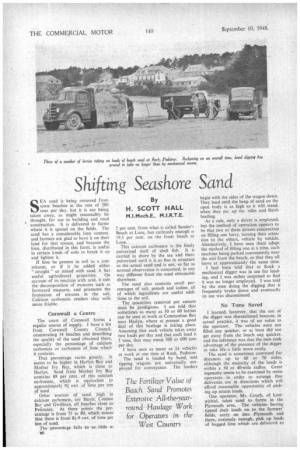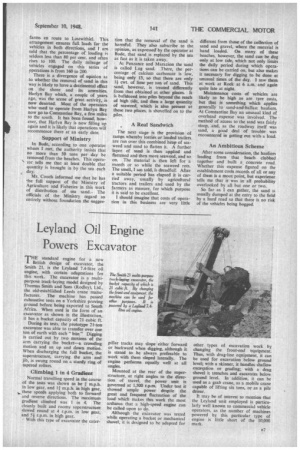Shifting Seashore Sand
Page 40

Page 41

If you've noticed an error in this article please click here to report it so we can fix it.
By
H. SCOTT HALL M.I.Mech.E., M.I.R.T.E. SEA sand is being removed from some beaches at the rate of 200 tons per day, but it is not being taken away, as might reasonably be thought, for use in building and road construction. It is delivered to farms where it is spread on the fields. The sand has a considerable lime content. and farmers are glad to have it on their land for that reason, and because the lime, distributed in this form, is useful in certain kinds of soils to break it up and lighten it.
If lime be present in soil as a constituent, or if it be added either " straight " or mixed with sand, it has useful agricultural properties. On account of its reaction with acid, it aids the decomposition of manures such as farmyard manures, and promotes the formation of nitrates in the soil. • Calcium carbonate renders clay soils more friable.
Cornwall a Centre
The coast of Cornwall forms a regular source of supply. I have a list from Cornwall County Council, enumerating 34 beaches and describing the quality of the sand obtained there, especially the percentage of calcium carbonate or carbonate of lime which it contains.
That percentage varies greatly. It seems to be higher in Harlyn Bay and Mother Ivy Bay, which is close to Harlyn. Sand from Mother Ivy Bay contains 88 per cent, of this calcium carbonate, which is equivalent to approximately 9i cwt. of lime per ton of sand.
Other sources of sand, high in calcium carbonate, are Hayle, Connor Bar and Gwithian, all beaches close to Penzance. At these 'points the percentage is from 75 to 80, which means that there is from 81-9 cwt. of lime per ton of sand.
The percentage falls to as little as B6 2 per cent, from what is called Sander's Beach at Looe, but curiously enough is 19.5 per cent. on the front beach at Looe.
This calcium carbonate is the finely pulverized shell of shell fish. It is carried in shore by the sea and there pulverized until it is as fine in structure as the actual sand and is not, so far as normal observation is concerned, in any way different from the sand obtainable elsewhere.
The sand also contains small percentages of salt, potash and iodine, all of which ingredients are useful additions to the soil.
The quantities removed per annum must be prodigious. I am told that sometimes as many as 50 or 60 lorries can be seen at work at Constantine Bay near Harlyn, where at present a good deal of this haulage is taking place. Assuming that each vehicle takes away two loads per day and that each load is 5 tons, that may mean 500 or 600 tons per day.
I have seen as many as 24 vehicles at work at one time at Rock, Padstow.
The sand is loaded by hand, and tipping wagons are universally employed for conveyance. The loaders
begin with the sides of the wagon down. They load until the heap of sand on the open body is as high as it will stand, when they pt' up the sides and finish loading.
As a rule, only a driver is employed, but the method of operation appears to be that two or three drivers concentrate on filling one lorry, turning their attention to the others, vehicle by vehicle. Alternatively, I have seen them adopt the Method of filling one at a time, each machine being parked conveniently near the exit from the beach, so that they all leave at approximately the same time.
I had been told that at Rock a mechanical digger was in use for loading, and I was rather surprised to find it was no longer employed. I was told by the men doing the digging that it frequently broke down and eventually its use was discontinued.
No Time Saved I learned, however, that the use of the digger was discontinued because, in actual practice, it was of no value to the operator. The vehicles were not filled any quicker, or at least did not get away from the beach any quicker, and the inference was that the men took advantage of the presence of the digger to take life a little more easily.
The sand is sometimes conveyed for distances up to 60 or 70 miles. although the majority of the loads is within a 30 or 40-mile radius. Great ingenuity seems to be exercised by some operators in order to arrange that deliveries are in directions wbich will afford reasonable opportunity of pick ing up return loads. '
One operator, Mr. Couch, of Lostwithiel, take t sand to farms in the Plymouth area. The vehicles having tipped their loads on to the farmers' fields, carry on into Plymouth and there, curiously enough, pick up loads of bagged lime which are delivered to farms en route to Lostwithiel. This arrangement ensures full loads for the vehicles in both directions, and I am told that the percentage of loading is seldom less than 80 per cent, and often rises to 100. The daily mileage of vehicles engaged on this series of operations is from 160 to 200.
There is a divergence of opinion as to whether the removal of sand in this way is likely to have a detrimental effect on the shore and its amenities. Marlyn Bay which, a couple of years ago, was the scene of great activity, is now deserted. Most of the operators who used to operate from Harlyn Bay now go to Constantine Bay, a few miles to the south. It has been found, however, that Harlyn Bay is now filling up again and it is likely that operations will recommence there at an early date.
Support of Ministry
In Bude, according to one operator whom I met, the authority insists that no more than 50 tons per day be removed from the beaches. This opera ' tor tells me that at least double that quantity is brought in by thc sea each day.
Mr. Couch informed me that he has the full support of the Ministry of Agriculture and Fisheries in this work of distribution of sea sand.. The officials of the Ministry regard as entirely without foundation the sugges
tion that the removal of the sand is harmful. They also subscribe to the opinion, as expressed by the operator at Rude, that sand is replaced by the sea as fast as it is taken away.
At Penzance and Marazion the sand is called Lug sand. There, the percentage of calcium carbonate is low, being only 13, so that there are only cwt. of lime per ton of sand. This sand, however, is treated differently from that obtained at other places. It is bulldozed into piles beyond the reach of high tide, and then a large quantity of seaweed, which is also present at these two places, is shovelled on to the piles.
A Real Sandwich •
The next stage is the provision of ramps whereby lorries or loaded trailers are run over this combined heap of seaweed and sand to flatten it. A further layer of sand is then applied and flattened and then more seaweed, and so on. The material is then left for a month or so while the seaweed rots. The smell, I am told, is dreadful! After a suitable period has elapsed it is carried away, usually by agricultural tractors and trailers and used by the farmers as manure. for Which purpose it is said to be excellent.
I should imagine that costs of operation in this business are very little
different from those of the collection of sand and gravel, where the material is hand loaded. On many of these beaches, however, the sand can be dug only at low tide, which not only limits the daily period during which operations can be carried on, but also makes it necessary for digging to be done at unusual times of the day. I saw them at work at Rock at 6 a.m. and again quite late at night.
Maintenance costs of vehicles are likely to be high as are tyre costs, but that is something which applies generally to sand-and-ballast hauliers. At Constantine Bay an unusual kind of overhead expense was involved. The method of access to the sand was fairly steep, and, as the roadway itself was sand, a good deal of trouble was encountered in getting out with a load.
An Ambitious Scheme
After some consideration, the hauliers leading from that beach clubbed together and built a concrete road. Whether this .expense figured on the establishment costs records of all or any of them is a moot point, but experience tells me that it was in all probability overlooked by all but one or two.
So far as I can gather, the sand is usually dumped at the entry to the field by a hard road so that there is no risk of the vehicles being bogged.




















































































